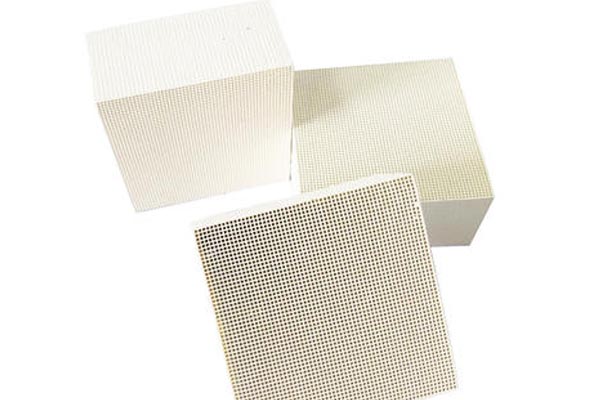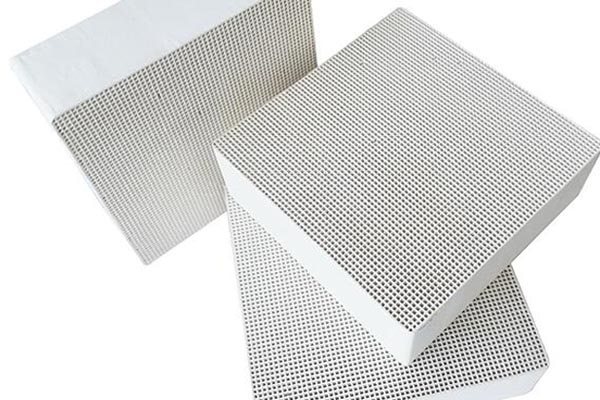
Honeycomb zeolite molecular sieve Jiangxi Zeolite molecular sieve carrier has many advantages: 1. It is stable in operation, and the concentration of waste gas can reach the standard stably; 2. It can be desorbed at high temperature, with high regeneration efficiency and high safety; 3. Honeycomb zeolite is used as the adsorption carrier, with small resistance; 4. Compact structure, small floor area of the whole equipment. 5. It has a wide range of applications and is suitable for treating various organic waste gases. The main material of honeycomb zeolite adsorbent is natural zeolite. The manufacturer of zeolite is composed of silica Inorganic microporous material composed of al_2o_3 and alkaline metal or alkaline earth metal, with inner pore volume accounting for 40-50% of the total volume and specific surface area of 100-500 m2/g, is characterized by high temperature resistance, non flammability, good thermal stability and hydrothermal stability. It is an efficient molecular sieve carrier with good adsorption performance, no secondary pollution, and can be regenerated at high temperature. Compared with honeycomb activated carbon, its performance is about 25% of its efficiency, However, it is widely used in the fields of adsorption, separation, catalysis and environment due to its high temperature resistance and difficult ignition. It is more suitable for the treatment of organic waste gas with large air volume and low concentration. Honeycomb zeolite molecular sieve high quality

Because there are uniform small internal pores in the molecular sieve structure, Honeycomb zeolite molecular sieve Jiangxi When the molecular linear degree of reactants and products is close to the pore size of the crystal, the selectivity of catalytic reaction often depends on the corresponding size of the molecule and pore size. This selectivity is called shape selective catalysis. There are two mechanisms leading to shape selectivity. One is caused by the difference of diffusion coefficient of molecules participating in the reaction in the pore cavity, which is called mass transfer selectivity; The other is caused by the space limitation of the transition state of the catalytic reaction, which is called transition state selectivity. Molecular sieve has clear pore cavity distribution, extremely high internal surface area (600m2/s), good thermal stability (1000 ℃), and adjustable acid site center. The acidity of molecular sieve mainly comes from three coordinated aluminum atoms and aluminum ions (AlO)+on the framework and in the pores. The OH based acid sensitive site center on the molecular sieve HY obtained by ion exchange, and the aluminum ion outside the framework will strengthen the acid site, forming the L acid site center. Polyvalent cations such as Ca2+, Mg2+and La3+can show the acid site center after exchange. The reduction of transition metal ions such as Cu2+and Ag+can also form acid site centers. In general, the higher the Al/Si ratio, the higher the specific activity of OH group. The modification of zeolite acidity can introduce protons through direct exchange of dilute hydrochloric acid. Honeycomb zeolite molecular sieve high quality This method often leads to dealumination of molecular sieve framework. So NaY will become NH4Y and then HY.

Honeycomb zeolite molecular sieve high quality Since UCC scientists invented synthetic molecular sieves in the late 1940s, UOP's molecular sieve technology has changed with each passing day. Today, UOP molecular sieve is famous for its high efficiency, low consumption and reliability. With the high adsorption capacity of UOP molecular sieve, users may reduce the loading capacity of molecular sieve and extend the adsorption cycle. More importantly, with this advantage, users can significantly reduce their investment and operating costs and reduce energy consumption. This is particularly noticeable in today's increasingly tense energy. The adsorption or repulsion function of molecular sieves is affected by the molecular electricity. Synthetic zeolite has the special function of selective adsorption according to the size and polarity of molecules, so it can dry or purify gas or liquid, Honeycomb zeolite molecular sieve Jiangxi This is also the basis for molecular sieve separation. Synthetic zeolite can meet the extensive demand of industry for adsorption and selective products, and is also widely used in industrial separation to synthesize zeolite molecular sieves. Advantages of UOP molecular sieve

The adsorption capacity of zeolite for organic pollutants mainly depends on the polar size and molecular diameter of organic molecules. Small molecules are easier to be adsorbed than large molecules, while polar molecules are easier to be adsorbed than non-polar ones. Different substances (such as organic molecules, metal ions and water molecules) exist in water, Honeycomb zeolite molecular sieve Jiangxi Their polarity and molecular size are different, and competition will occur during adsorption. The main material of honeycomb zeolite adsorbent is natural zeolite. The manufacturer of zeolite is composed of silica Inorganic microporous material composed of al_2o_3 and alkaline metal or alkaline earth metal, with inner pore volume accounting for 40-50% of the total volume and specific surface area of 100-500 m2/g, is characterized by high temperature resistance, non flammability, good thermal stability and hydrothermal stability. It is an efficient molecular sieve carrier with good adsorption performance, no secondary pollution, and can be regenerated at high temperature. Compared with honeycomb activated carbon, its performance is about 25% of its efficiency, Honeycomb zeolite molecular sieve Direct selling However, it is widely used in the fields of adsorption, separation, catalysis and environment due to its high temperature resistance and difficult ignition. It is more suitable for the treatment of organic waste gas with large air volume and low concentration.

Honeycomb zeolite molecular sieve Jiangxi Because the aluminum oxide tetrahedron of zeolite has a negative charge, and the skeleton hole contains cations, a strong electric field is formed around the cations. Therefore, the adsorption force of zeolite not only has a strong dispersion force, but also has a large electrostatic force. It is precisely because of this electrostatic relationship that zeolites have preferential selective adsorption on polar, unsaturated and polarizable molecules. It can strongly adsorb molecules containing polar groups such as hydroxyl ion, ammonium ion and other polarizable groups, especially water, which can form hydrogen bonds with aluminum silicon skeleton, so zeolite has strong water absorption. It can still adsorb even under low relative humidity and concentration, and its water absorption is higher than that of silica gel and activated alumina. The main material of honeycomb zeolite adsorbent is natural zeolite. The manufacturer of zeolite is composed of silica Inorganic microporous material composed of al_2o_3 and alkaline metal or alkaline earth metal, with inner pore volume accounting for 40-50% of the total volume and specific surface area of 100-500 m2/g, is characterized by high temperature resistance, non flammability, good thermal stability and hydrothermal stability. It is an efficient molecular sieve carrier with good adsorption performance, no secondary pollution, and can be regenerated at high temperature. Compared with honeycomb activated carbon, its performance is about 25% of its efficiency, However, it is widely used in the fields of adsorption, separation, catalysis and environment due to its high temperature resistance and difficult ignition. It is more suitable for the treatment of organic waste gas with large air volume and low concentration.




